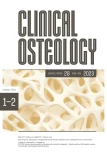Exostosis of proximal femur – benign tumor, “malign” location: a case report
Authors:
Rendek Pavol 1; Kokavec Milan 1; Chládek Petr 2
Authors‘ workplace:
Ortopedická klinika LF UK a NÚDCH, Bratislava
1; Ortopedické oddělení, Vršovická Zdravotní, a. s., Praha
2
Published in:
Clinical Osteology 2023; 28(1-2): 31-33
Category:
Overview
Osteocartilaginous exostosis, also called osteochondroma, is a benign bone tumor for most localized near the epiphyseal plate. It is the most common bone tumor, representing about 20–50 % of all benign bone tumors. Its radiological image is very typical – it is most often a pediculate formation with a cartilaginous cap. Osteochondromas can be solitary, cases of multiple occurrence are called hereditary multiple enchondromatosis (HME). Histologically it is categorized as a benign affection, clinically presenting with pain, a local palpable mass and restriction of movement. Histological malignization of the tumor is rare, reported in 1 % of cases. In the tumor can however be considered malignant in cases of adverse localization. In this article we present the case of a 15-year-old boy with an exostosis of the proximal femur with a prominent ischiofemoral impingement syndrome. After a biopsy and a partial resection, the tumor was treated via the surgical hip dislocation technique, which allows access to the femoral head without compromising its nutritional blood vessels. After a radical resection, the patient has been monitored for 4 years and his clinical and radiological condition is satisfactory.
Keywords:
proximal femur – surgical hip dislocation – exostosis – osteochondroma
Sources
1. Scarborough MT, Moreau G. Benign cartilage tumors. Orthop Clin North Am 1996; 27(3): 583–589.
2. Wang SK, Park BM. Induction of osteochondromas by periosteal resection. Orthopedics 1991; 14(7): 809–812. Dostupné z DOI: <http://dx.doi.org/10.3928/0147–7447–19910701–16>.
3. Karasick D, Schweitzer ME, Eschelman DJ. Symptomatic osteochondromas: imaging features. AJR Am J Roentgenol 1997; 168(6): 1507–1512. Dostupné z DOI: <http://dx.doi.org/10.2214/ajr.168.6.9168715>.
4. De Beuckeleer LH, De Schepper AM, Ramon F. Magnetic resonance imaging of cartilaginous tumors: is it useful or necessary? Skeletal Radiol 1996; 25(2): 137–141. D ostupné z DOI: < http://dx.doi.org/10.1007/s002560050050>.
5. Murphey MD, Choi J, Kransdorf MJ et al. Imaging of osteochondroma: Variants and complications with radiologic-pathologic correlation. Radiographics 2000; 20(5): 1407–1434. Dostupné z DOI: <http://dx.doi.org/10.1148/radiographics.20.5.g00se171407>.
6. Humbert ET, Mehlman C, Crawford AH. Two cases of osteochondroma recurrence after resection. Am J Orthop (Belle Mead NJ); 2001: 30(1): 62–64.
7. Siebenrock KA, Ganz R. Osteochondroma of the femoral neck. Clin Orthop Relat Res 2002; (394): 211–218. Dostupné z DOI: <http://dx.doi.org/10.1097/00003086–200201000–00025>.
Labels
Clinical biochemistry Paediatric gynaecology Paediatric radiology Paediatric rheumatology Endocrinology Gynaecology and obstetrics Internal medicine Orthopaedics General practitioner for adults Radiodiagnostics Rehabilitation Rheumatology TraumatologyArticle was published in
Clinical Osteology

2023 Issue 1-2
Most read in this issue
- Exostosis of proximal femur – benign tumor, “malign” location: a case report
- Reflection on the causes of senile osteoporosis
- Pregnancy associated osteoporosis
- Jak a čím žije česká klinická osteologie v dnešní době
